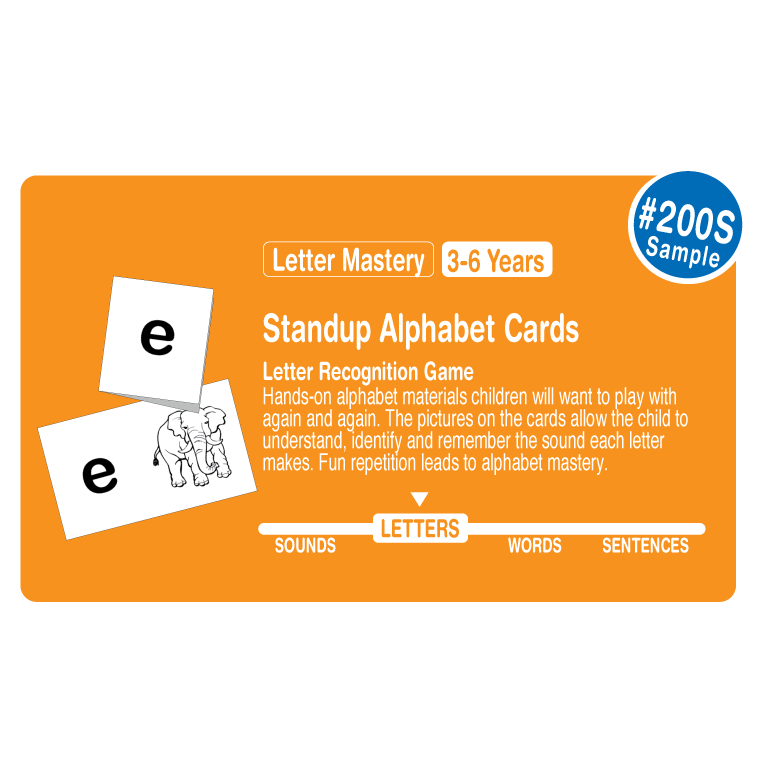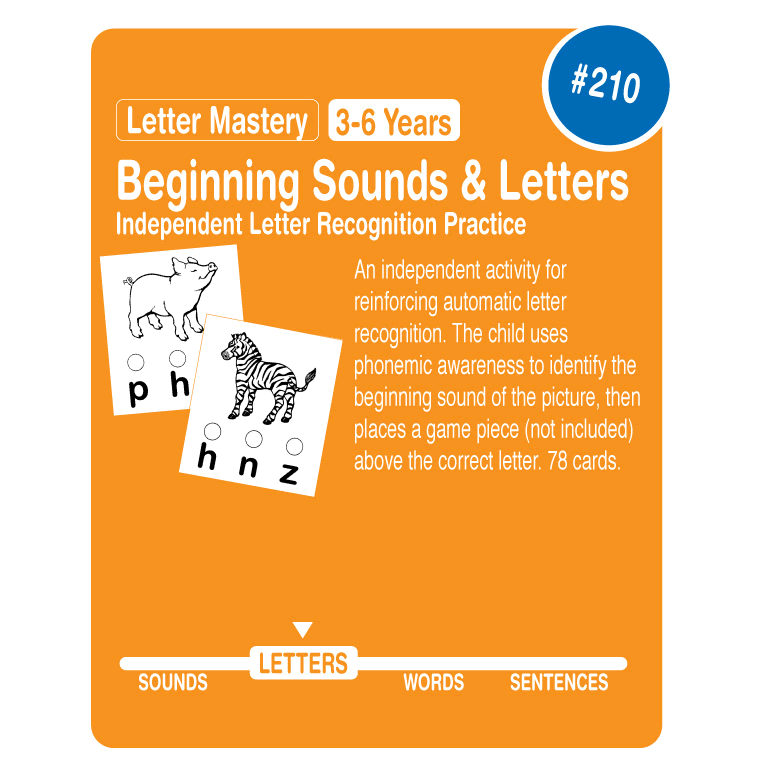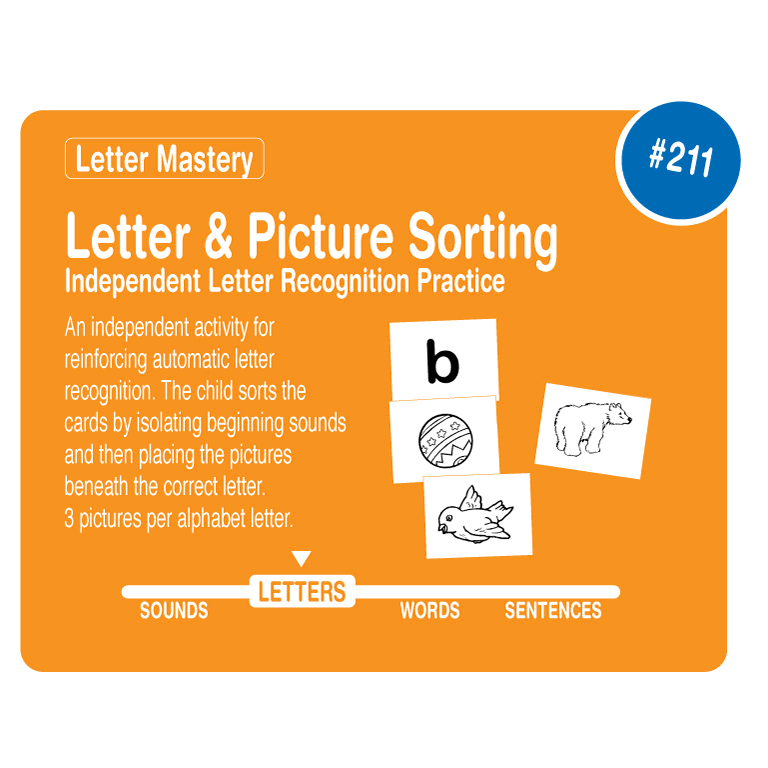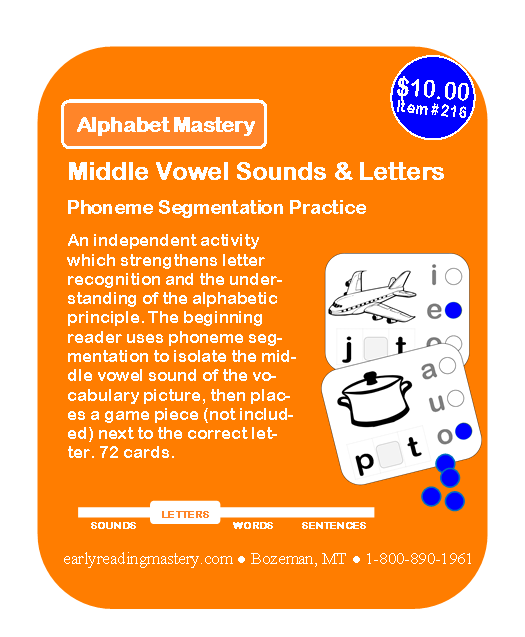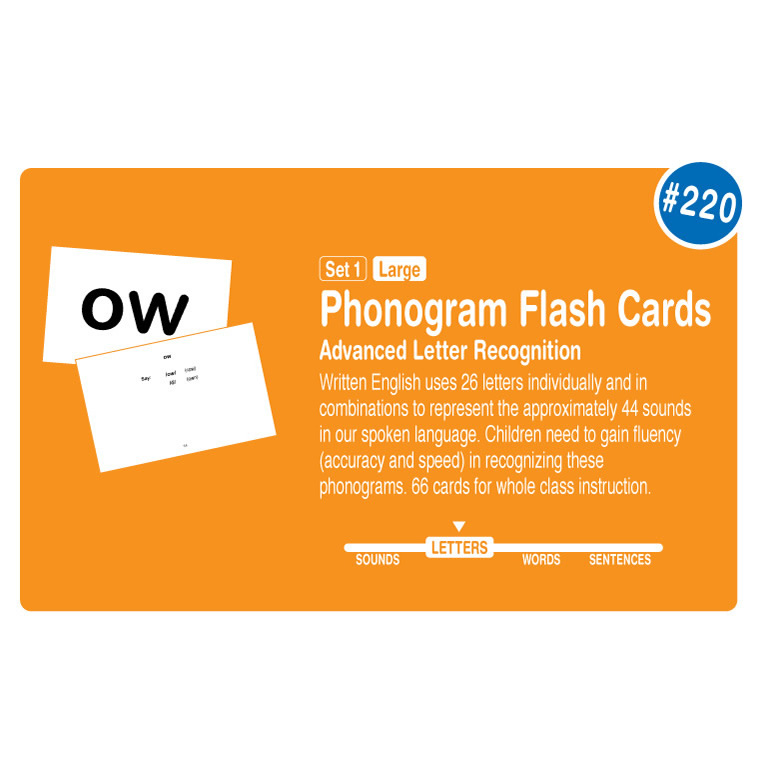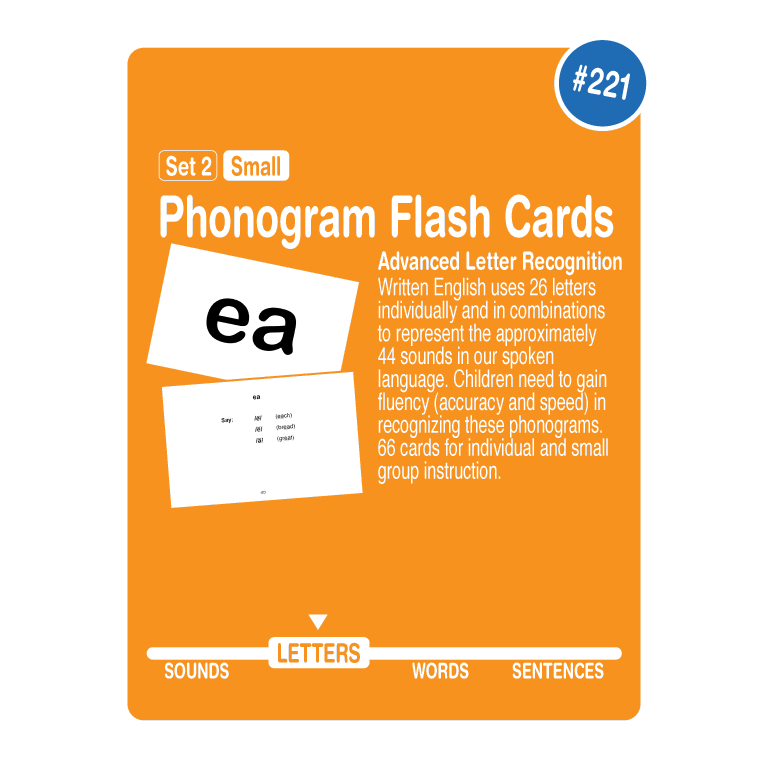Letter Recognition & the Alphabetic Principle
After phonemic awareness, the best predictor of early reading achievement is letter recognition. However, accuracy of letter recognition is not enough. The speed and fluency with which a child recognizes letters is strongly related to reading achievement among beginning readers. Therefore the goal of letter recognition work must be mastery (accuracy and speed).
Teach the alphabetic principle before you teach the alphabet.
Before beginning formal instruction in letter-sounds, show the child how to use her phonemic awareness to identify an alphabet letter by its sound when the letter is linked with an object or picture. Because the child now understands the alphabetic principle (that letters and speech sounds map onto each other), she is prepared to understand, identify, learn and remember the 26 alphabet letter-sounds.
Standup Alphabet Cards [Small Set]
Letter Recognition Game
Price: $10.00
Item #200 (S)
Hands-on alphabet materials children will want to play with again and again. The pictures on the cards allow the child to identify, understand and remember the sound each letter makes. Fun repetition leads to alphabet mastery.
Continue reading →
Hands-on alphabet materials children will want to play with again and again. The pictures on the cards allow the child to identify, understand and remember the sound each letter makes. Fun repetition leads to alphabet mastery.
Continue reading →
Standup Alphabet Cards [Large Set]
Letter Recognition Game
Price: $12.00
Item #200
Hands-on alphabet materials children will want to play with again and again. The pictures on the cards allow the child to understand, identify and remember the sound each letter makes. Fun repetition leads to alphabet mastery.
Continue reading →Hands-on alphabet materials children will want to play with again and again. The pictures on the cards allow the child to understand, identify and remember the sound each letter makes. Fun repetition leads to alphabet mastery.
Continue reading →Teach Letter Mastery.
The child must master the alphabet sounds through games and activities that produce meaningful repetition. He should learn them by sound, not by name. (Names will come later.) The alphabet is best divided into clusters, arranged so as not to create confusion between similar looking or sounding letters. The child masters one cluster at a time—in sequence—until all 26 letters are learned. Introduction to decoding does not begin until the child has achieved some level of mastery (accuracy and speed) of the entire alphabet. Recommended clusters: [1] a, g, h, m, s; [2] c, d, l, o, t; [3] f, i, p, r, u, [4] e, j, k, n, w; [5] b, v, y, z, qu, x.
Beginning Sounds & Letters
Independent Letter Recognition Practice
Price: $10.00
Item #210
An independent activity for reinforcing automatic letter recognition. The child uses phonemic awareness to identify the beginning sound of the picture, then places a game piece (not included) above the correct letter. 78 cards.

Continue reading →
An independent activity for reinforcing automatic letter recognition. The child uses phonemic awareness to identify the beginning sound of the picture, then places a game piece (not included) above the correct letter. 78 cards.

Continue reading →
Letter & Picture Sorting
Independent Letter Recognition Practice
Price: $12.00
Item #211
An independent activity for reinforcing automatic letter recognition. The child sorts the cards by isolating beginning sounds and then placing the pictures beneath the correct letter. 3 pictures per alphabet letter.
An independent activity for reinforcing automatic letter recognition. The child sorts the cards by isolating beginning sounds and then placing the pictures beneath the correct letter. 3 pictures per alphabet letter.
Alphabet Mastery Game
Independent Letter Recognition Practice
Price: $8.00
Item #212
An independent activity for reinforcing automatic letter recognition. Cards are placed in a stack, pictures facing down. The child identifies the letter (by sound first, later by name) and then turns the cards over to verify his answer. 52 cards. Lower case and upper case sets.

Continue reading →
An independent activity for reinforcing automatic letter recognition. Cards are placed in a stack, pictures facing down. The child identifies the letter (by sound first, later by name) and then turns the cards over to verify his answer. 52 cards. Lower case and upper case sets.

Continue reading →
Blended Sounds and Letters
Independent Letter Recognition Practice
Price: $10.00
Item #214
An independent activity for reinforcing automatic recognition of letter patterns. The student uses phoneme segmentation to isolate the first two sounds of the vocabulary picture, then places a game piece (not included) above the correct letters. 66 cards.


Continue reading →
An independent activity for reinforcing automatic recognition of letter patterns. The student uses phoneme segmentation to isolate the first two sounds of the vocabulary picture, then places a game piece (not included) above the correct letters. 66 cards.


Continue reading →
Ending Sounds and Letters
Independent Letter Recognition Practice
Price: $10.00
Item #215
An independent activity which strengthens letter recognition and the understanding of the alphabetic principle. The beginning reader uses phoneme segmentation to isolate the last sound of the vocabulary picture, then places a game piece (not included) next to the correct letter. 72 cards.


Continue reading →
An independent activity which strengthens letter recognition and the understanding of the alphabetic principle. The beginning reader uses phoneme segmentation to isolate the last sound of the vocabulary picture, then places a game piece (not included) next to the correct letter. 72 cards.


Continue reading →
Middle Vowel Sounds & Letters
Phoneme Segmentation Practice
Price: $10.00
Item #216
An independent activity which strengthens letter recognition and the understanding of the alphabetic principle. The beginning reader uses phoneme segmentation to isolate the middle vowel sound of the vocabulary picture, then places a game piece (not included) next to the correct letter. 72 cards.

 Continue reading →
Continue reading → An independent activity which strengthens letter recognition and the understanding of the alphabetic principle. The beginning reader uses phoneme segmentation to isolate the middle vowel sound of the vocabulary picture, then places a game piece (not included) next to the correct letter. 72 cards.

 Continue reading →
Continue reading → Middle Vowel Sorting Game
Phoneme Segmentation Practice
Price: $10.00
Item #217
An independent activity which strengthens short vowel recognition and the understanding of the alphabetic principle. The beginning reader uses phoneme segmentation to isolate the middle vowel sound of the vocabulary picture, then places the picture card beneath the correct short vowel. 8 picture cards per vowel.

Continue reading →
An independent activity which strengthens short vowel recognition and the understanding of the alphabetic principle. The beginning reader uses phoneme segmentation to isolate the middle vowel sound of the vocabulary picture, then places the picture card beneath the correct short vowel. 8 picture cards per vowel.

Continue reading →
Letter & Picture Matching Game
Independent Letter Recognition Practice
Price: $10.00
Item #218
An independent activity which strengthens letter recognition and the understanding of the alphabetic principle The learner uses beginning sound isolation to identify which pictures match the letter in the center of the card.
80 cards.
 Continue reading →
Continue reading → An independent activity which strengthens letter recognition and the understanding of the alphabetic principle The learner uses beginning sound isolation to identify which pictures match the letter in the center of the card.
80 cards.
 Continue reading →
Continue reading → Phonogram Flash Cards Set 1 [Large]
Advanced Letter Recognition
Price: $18.00
Item #220
Written English uses 26 letters individually and in combinations to represent the approximately 44 sounds in our spoken language. Children need to gain fluency (accuracy and speed) in recognizing these phonograms. 66 cards.
Continue reading →Written English uses 26 letters individually and in combinations to represent the approximately 44 sounds in our spoken language. Children need to gain fluency (accuracy and speed) in recognizing these phonograms. 66 cards.
Continue reading →Phonogram Flash Cards Set 2 [Small]
Advanced Letter Recognition
Price: $15.00
Item #221
Written English uses 26 letters individually and in combinations to represent the approximately 44 sounds in our spoken language. Children need to gain fluency (accuracy and speed) in recognizing these phonograms. 66 cards.
Continue reading →Written English uses 26 letters individually and in combinations to represent the approximately 44 sounds in our spoken language. Children need to gain fluency (accuracy and speed) in recognizing these phonograms. 66 cards.
Continue reading →General
The Klein Method of Early Reading Mastery by Randall Klein
Price: $14.50
Item #502
…Teaching Children How to Teach Themselves to Read
Principles of Teaching Children How to Teach Themselves to Read
• Children in large part teach themselves to read
from the instruction and activities we provide
them. They learn how to figure out things on their
own, like unfamiliar phonograms and new spelling
patterns.
• The application of the alphabetic principle to
identify letters and words is the basis of all the activities
in this method and it is how the child will
teach himself to read.
• Effective early reading instruction is based on activities
that guide the student from speech to print,
from sound to symbol and which move from the
concrete to the abstract.
• Teach the alphabetic principle before you teach
the alphabet.
• The foundation of alphabet mastery is beginning
sound isolation.
• Letter knowledge is best learned by the child
through his application of the alphabetic principle
using self-guided materials to match beginning
sounds to printed letters.
• The foundation of reading and spelling words is
phoneme segmentation, the most important beginning
reading skill. Struggling readers often lack
this ability to separate spoken words into individual
sounds.
• Decoding skills are best learned by the child
through his application of the alphabetic principle
using self-guided materials to match sounds of
spoken words to letters in printed words.
• The organization of materials in the environment
is crucial in implementing effective early reading
instruction. The various games and activities
for each skill level are grouped together in
an attractive manner and made easily accessible
to students. This helps to structure the learning
environment so that students understand which
games they may freely choose to work with.
• Freedom to choose is key to gradually shifting responsibility
for learning to the student.
• Freedom to choose individualizes the learning experience
for the student according to his strengths
and interests.
• Teaching is not testing. Don’t ask a student a question
unless you are sure he knows the answer. If
the child gives a wrong answer, that means you’ve
asked the wrong question. If you give him a choice
of answers, he will usually choose the right one.
• Repetition is the teacher’s best teaching tool and
the quickest, most direct way for a student to master
skills and information. Repetition is the healing
balm of education.
• Emphasis must shift from a traditional model of
memorization through drill, to a deeper, more
permanent learning through self-guided handson
activities.
• Do not do for the child what he can do for himself.
…Teaching Children How to Teach Themselves to Read
Principles of Teaching Children How to Teach Themselves to Read
• Children in large part teach themselves to read
from the instruction and activities we provide
them. They learn how to figure out things on their
own, like unfamiliar phonograms and new spelling
patterns.
• The application of the alphabetic principle to
identify letters and words is the basis of all the activities
in this method and it is how the child will
teach himself to read.
• Effective early reading instruction is based on activities
that guide the student from speech to print,
from sound to symbol and which move from the
concrete to the abstract.
• Teach the alphabetic principle before you teach
the alphabet.
• The foundation of alphabet mastery is beginning
sound isolation.
• Letter knowledge is best learned by the child
through his application of the alphabetic principle
using self-guided materials to match beginning
sounds to printed letters.
• The foundation of reading and spelling words is
phoneme segmentation, the most important beginning
reading skill. Struggling readers often lack
this ability to separate spoken words into individual
sounds.
• Decoding skills are best learned by the child
through his application of the alphabetic principle
using self-guided materials to match sounds of
spoken words to letters in printed words.
• The organization of materials in the environment
is crucial in implementing effective early reading
instruction. The various games and activities
for each skill level are grouped together in
an attractive manner and made easily accessible
to students. This helps to structure the learning
environment so that students understand which
games they may freely choose to work with.
• Freedom to choose is key to gradually shifting responsibility
for learning to the student.
• Freedom to choose individualizes the learning experience
for the student according to his strengths
and interests.
• Teaching is not testing. Don’t ask a student a question
unless you are sure he knows the answer. If
the child gives a wrong answer, that means you’ve
asked the wrong question. If you give him a choice
of answers, he will usually choose the right one.
• Repetition is the teacher’s best teaching tool and
the quickest, most direct way for a student to master
skills and information. Repetition is the healing
balm of education.
• Emphasis must shift from a traditional model of
memorization through drill, to a deeper, more
permanent learning through self-guided handson
activities.
• Do not do for the child what he can do for himself.
